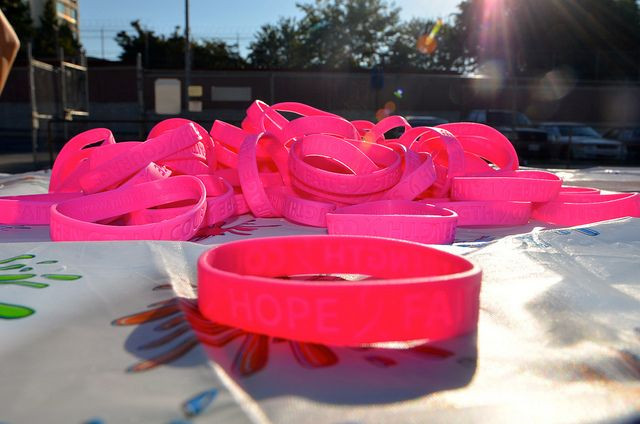Think Pink? How Some 'Pinkwashing' Breast Cancer Campaigns May Be Contributing To The Disease's Spread

October marks the beginning of Breast Cancer Awareness Month, and although donating to breast cancer research is encouraged, Breast Cancer Action wants to raise awareness of "pinkwashing" campaigns and remind consumers to think before they buy pink.
Pinkwashing describes companies or organizations who use the pink ribbon emblem in an effort to raise money for a cure but simultaneously sell products linked to causing the disease. For example, fast food companies supporting breast cancer awareness would be considered guilty of pinkwashing, since obesity and a high-fat diet have been cited as major contributing factors to the disease. Because the pink ribbon is not regulated by any agency, however, ultimately any organization can display it without consequence.
Worst Offenders
In recent years, many companies have come under fire for pinkwashing campaigns. A notable example of this is Alhambra’s breast cancer campaign for its Athena water. Although, its website claims the campaign raised over $2 million for breast cancer research, The Daily Beast reported that the Athena water also uses bisphenol A (BPA) in its plastic bottles. While the FDA has deemed BPA safe for container use, studies have linked the chemical to health issues, including the growth of cancerous cells.
Susan G. Komen for the Cure, one of the most popular cancer charities, is also one of the most notable culprits of “pinkwashing” and has been criticized numerous times for it. Examples include the charity's 2011 partnership with Sally Beauty, which came under fire after it became widely known that a number of the Sally Beauty products contained chemicals specifically linked to breast cancer, such as triclosan and phthalate, The Daily Beast reported. Susan G. Komen was also criticized for its partnership with the oil corporation Baker Hughes, in their “Doing Our Bit for the Cure” campaign. While the partnership may have had good intentions, according to The Daily Beast, Baker Hughes’ fracking has been linked with potentially adding carcinogens to the environment. Susan G. Komen’s partnerships with Kentucky Fried Chicken and Yoplait yogurt were also criticized for similar reasons. Although many may be quick to blame Komen for taking advantage of the public’s generosity, according to Gayle Sulik, sociologist and author of Pink Ribbon Blues, it's only part of a much bigger issue.
"Komen is the largest and is held up as the gold standard. But it is just part of it," Sulik, told The Guardian in 2012. "There's the conflict of interest. … Then 'pinkwash,' where products might be carcinogenic, to unhealthy products like M&Ms. I've even heard of Pub Crawls for the Cure. It's part of the general culture."
Where Your Money Goes
Consumers can help to protect themselves from giving money to pinkwashing campaigns by critically questioning how much of their money is being donated and what exactly their donations are paying for. Some companies may just sport a pink ribbon to insinuate that their products are “healthy” without actively donating sale profits to charity. For example, Breast Cancer Action reported that in 2010 the Dansko shoe company sold pink ribbon clogs despite shoe sale profits having no effect on how much the company donated to its partner, Susan G. Komen.
Research is necessary to help find new treatments and possibly a cure, and much of our donation money is meant to fund these important studies. However, earlier this year, the Federal Trade Commission charged four cancer charities; Cancer Fund of America Inc., Cancer Support Services Inc., Children’s Cancer Fund of America Inc., and The Breast Cancer Society Inc. with using an “overwhelming majority of donations to benefit only the perpetrators, their families and friends, and fundraisers,” a press statement read. Other popular cancer charities, such as the American Cancer Society and Susan G. Komen for the Cure, have been noted for spending more donation money on fundraising expenses and public education programs than actual cancer research.
Although the world of cancer charities may be treacherous, there are good charities who actually do what they advertise. For example, CNBC reported that Gateway for Cancer Research only funds research and promises 99 cents of each dollar donated will go to finding better treatment and cures for cancer. So, the key is doing your research and making sure that your donation will actually go where you want it to.
Correction: An earlier version of this story incorrectly stated the name of the charity, Gateway for Cancer Research. It has now been corrected.
Published by Medicaldaily.com



























